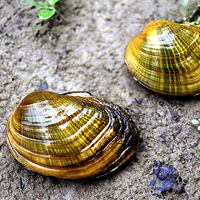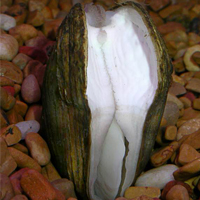Northern riffleshell
Scientific name: Epioblasma torulosa rangiana


Cover photos credit: M C Barnhart, Missouri State University (left) and S. Staton, National Water Research Institute, Environment Canada (right)
Status
Endangered
“Endangered” means the species lives in the wild in Ontario but is facing imminent extinction or extirpation.
Date added to the Species at Risk in Ontario List
The Northern Riffleshell was already assessed as endangered when the Endangered Species Act took effect in 2008.
Read the Assessment Report
What it looks like
The Northern Riffleshell is a small (4.5 to 7.5 centimetres long), colourful freshwater mussel.
The shell is brownish-yellow to yellowish-green with thin, diffuse green rays. This species can live up to 15 years.
Females can be distinguished by the broadly rounded edge on the end of the shell.
Where it lives
In Ontario, the Northern Riffleshell is found in riffle areas within rivers or streams with rocky, sand, or gravel bottoms.
Like all freshwater mussels, this species feeds on algae and bacteria that it filters out of the water.
Mussel larvae are parasitic and must attach to a fish host, where they consume nutrients from the fish body until they transform into juvenile mussels and drop off.
In North America, the Northern Riffleshell’s range has decreased by 95 per cent.
The presence of fish hosts is one of the key features for an area to support a healthy mussel population.
Where it’s been found in Ontario
The Northern Riffleshell is believed to have several potential fish hosts in Ontario: Blackside Darter, Fantail Darter, Iowa Darter, Johnny Darter, Rainbow Darter, Logperch, Brown Trout and Mottled Sculpin.
In Ontario, it is now only found in the Sydenham River and Ausable River in southwestern Ontario.
Populations in Lake Erie, Lake St. Clair and the Detroit River have disappeared.
View a Larger version of this map (PDF)
What threatens it
The most significant threat to the Northern Riffleshell is habitat degradation due to siltation, which occurs when soil washes into the river from nearby agricultural and urban areas.
Pollution and invasive species are also serious problems.
The invasive Zebra Mussel, which was accidentally introduced from Europe, has been responsible for the disappearance of the Northern Riffleshell from Lakes Erie and St. Clair and the Detroit River.
These invaders attach to native mussels in large numbers, causing them to suffocate or die from starvation.
A decline in the population of fish hosts could also pose a threat.
Action we are taking
Endangered Species and their general habitat are automatically protected
Recovery strategy
A recovery strategy advises the ministry on ways to ensure healthy numbers of the species return to Ontario.
Read the executive summary (September 10, 2010)
Read the recovery strategy (September 10, 2010)
Government response statement
A government response statement outlines the actions the government intends to take or support to help recover the species.
Read the government response statement (June 15, 2011)
Five-Year Review of Progress
A five-year review reports on progress made toward protecting and recovering a species, within five years of publishing a species’ government response statement.
Read the report on progress towards the protection and recovery of 27 species at risk, including Northern Riffleshell (2016).
Habitat protection
General Habitat Protection - June 30, 2013
What you can do
Report a sighting
- The Ministry of Natural Resources tracks species at risk such as the Northern Riffleshell. Report a sighting of an endangered animal or plant to the Natural Heritage Information Centre. Photographs with specific locations or mapping coordinates are always helpful.
Volunteer
- Volunteer with your local nature club or provincial park to participate in surveys or stewardship work focused on species at risk.
Be a good steward
- Private land owners have a very important role to play in species recovery. If you find Northern Riffleshell in a watercourse on or adjacent to your property, you may be eligible for stewardship programs that support the protection and recovery of species at risk and their habitats.
- Invasive species seriously threaten many of Ontario’s species at risk. To learn what you can do to help reduce the threat of invasive species, visit:
www.ontario.ca/invasivespecies
www.invadingspecies.com
www.ontarioinvasiveplants.ca
www.dfo-mpo.gc.ca/science/enviro/ais-eae/index-eng.htm. - Farmers and land owners can help improve fish habitat and keep Ontario’s water safe and clean by maintaining natural vegetation next to creeks and rivers, and keeping pollution and soil from washing into Ontario’s streams and rivers. For more information about programs and funding assistance for eligible land owners visit the Ontario Soil and Crop Improvement Association website at:
www.ontariosoilcrop.org/en/programs/species_at_risk.htm.
Report illegal activity
- Report any illegal activity related to plants and wildlife to
1-877-TIP-SMNR (847-7667) .
Quick facts
- The Northern Riffleshell can fish. Mussel larvae won’t survive without attaching to a fish, where they live as parasites consuming nutrients from the fish body. The female Northern Riffleshell produces a bright white lure to attract a fish and sometimes even captures it by clamping down its shell. The mussel then pumps out a cloud of larvae that attach to the stunned fish.
- Aboriginal people harvested mussels for food and to create jewelry and tools. In the 1800s, massive numbers of mussels were harvested from the Grand River to create buttons. Millions were shipped out every year until the 1940s when plastic buttons became more popular.
- Mussels are indicators of environmental health. Since mussels have complex life cycles, are long-lived species (some can live up to 100 years!) and feed by filtering water and its pollutants, mussels can provide a snapshot of how healthy our waterways are.
- Northern Riffleshell may be the most imperiled mussel species we have in Ontario, as it is believed there are fewer than 15 locations where this species occurs globally.
